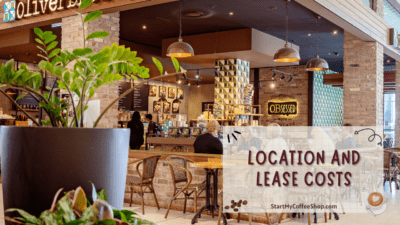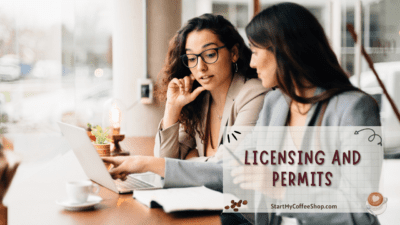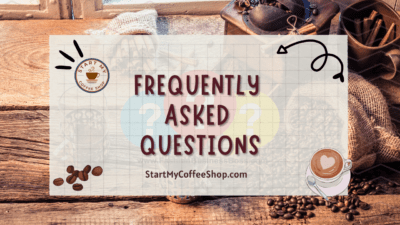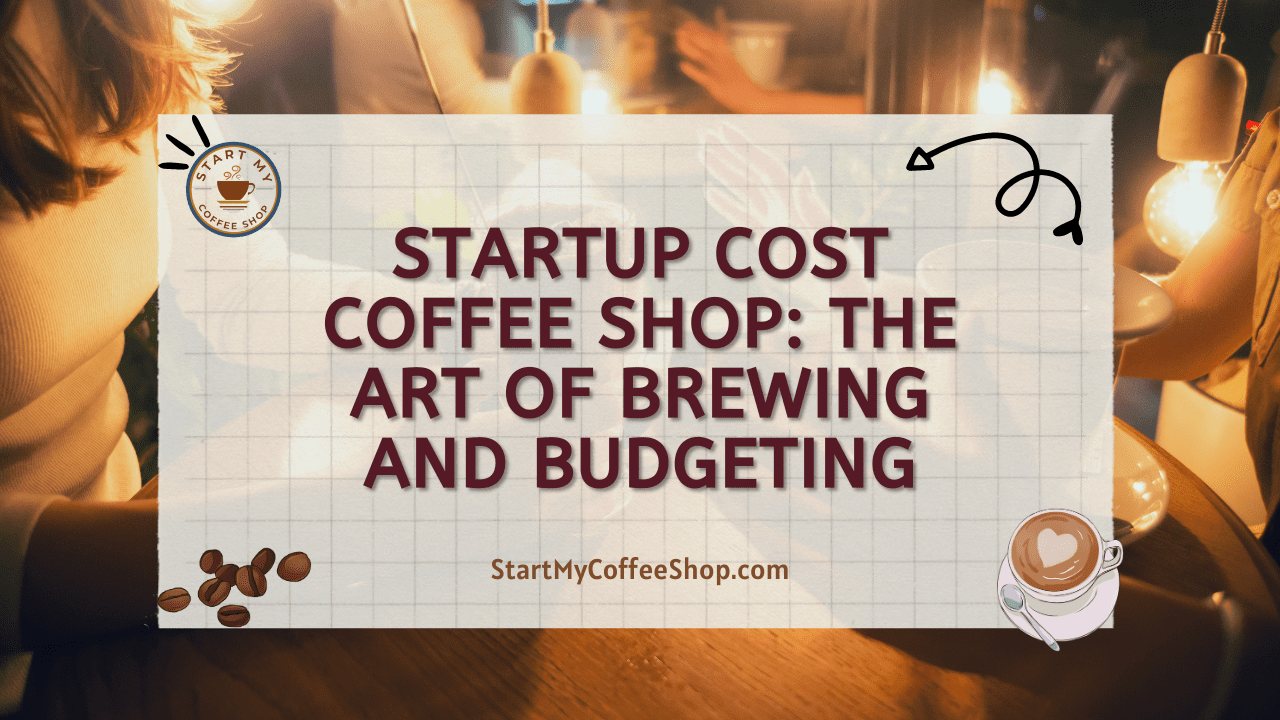Opening a coffee shop can be a dream come true for many aspiring entrepreneurs. However, it’s essential to understand the financial aspects before embarking on this exciting venture.
Startup costs for opening a coffee shop vary, but they typically range from $50,000 to $300,000. Factors influencing costs include location, equipment, renovations, permits, inventory, marketing, and staffing.
In this article, I will explore the start-up costs associated with opening a coffee shop, providing valuable insights and tips for progress.
1. Location and Lease Costs
When it comes to opening a coffee shop, selecting the perfect location plays a vital role in its improvement. Choosing a high-traffic area is essential to attract a steady stream of customers. Areas near offices, colleges, or residential neighborhoods are particularly advantageous as they offer a built-in customer base.

The location’s lease cost is a significant consideration in your financial planning. Lease costs can vary significantly depending on factors such as the location’s desirability, the size of the space, and local market conditions. In prime areas, lease costs can range from a few thousand dollars to tens of thousands per month. It’s crucial to carefully evaluate your budget and assess the potential revenue generation of the location before making a decision.
While higher lease costs in bustling areas may seem intimidating, the potential for increased foot traffic and customer engagement can outweigh the expenses. A well-chosen location can lead to higher sales and brand exposure, contributing to the overall performance of your coffee shop.
Additionally, it’s important to consider other factors when choosing a location, such as visibility, accessibility, parking availability, and competition. A location with good visibility and easy access can attract more customers and enhance the convenience of your coffee shop. Analyzing the competition in the area can also provide insights into the market demand and help you differentiate your offerings.
Read more about Cost to Open Coffee Shop Average: From Concept to Cash Register
2. Renovations and Interior Design
Creating a welcoming ambiance is crucial when transforming a space into a coffee shop. Renovations and interior design play a significant role in achieving this goal. Renovation costs can vary depending on the scope of work and the condition of the space.
Structural modifications may be necessary to optimize the layout and flow of the coffee shop. This could involve knocking down walls, building partitions, or adding new structures. Plumbing and electrical work are essential for setting up sinks, water lines, espresso machines, lighting fixtures, and other equipment. These tasks often require the expertise of professionals, adding to the overall renovation costs.
Flooring options range from tiles to hardwood or polished concrete, each with its cost considerations. Lighting is an important aspect that creates the desired atmosphere, and fixtures like pendant lights, track lighting, or wall sconces may be incorporated. Furniture, including tables, chairs, sofas, and counters, contribute to the comfort and functionality of the space. Decor elements such as artwork, wall coverings, plants, and signage add personality and style.
Renovation costs can range from several thousand to tens of thousands of dollars, depending on the size of the space, the level of transformation required, and the quality of materials and finishes chosen. It is important to carefully plan and budget for these expenses to ensure the desired outcome while maintaining financial feasibility.
3. Equipment and Supplies
To provide customers with an exceptional coffee experience, it is essential to invest in high-quality coffee equipment. The core equipment necessary for a coffee shop includes espresso machines, grinders, brewers, refrigeration units, dishwashers, and POS systems.
Espresso machines are the heart of any coffee shop, allowing baristas to create the perfect espresso shots. Grinders ensure the beans are freshly ground to maintain the coffee’s flavor and aroma. Brewers come in various types, such as drip brewers or pour-over systems, enabling the preparation of different coffee beverages.
Refrigeration units are essential for storing milk, syrups, and other perishable ingredients, ensuring freshness and food safety. Dishwashers help maintain cleanliness and hygiene by efficiently washing cups, mugs, and other utensils.
In addition to equipment, stocking up on supplies is crucial. Coffee beans, the star ingredient, should be of high quality and sourced from reputable suppliers. Syrups, milk, cups, napkins, and cleaning materials are essential for the day-to-day operations of the coffee shop.
The costs associated with coffee equipment and supplies can vary depending on the brand, quality, and quantity required. On average, a coffee shop can expect to spend between $20,000 to $50,000 or more on equipment and supplies, depending on its specific needs and scale of operations.
Investing in reliable and efficient equipment ensures that your coffee shop can consistently deliver a high-quality product to customers. It not only enhances the customer experience but also contributes to the overall efficiency of your business. Careful consideration should be given to selecting equipment and suppliers that align with your coffee shop’s vision, quality standards, and budgetary constraints.
4. Licensing and Permits
Operating a coffee shop legally requires obtaining the necessary licenses and permits. The specific permits and licenses required may vary based on your location and the services you plan to offer. Common permits include health permits, food handling permits, and zoning permits.
Health permits ensure that your coffee shop meets sanitation and safety standards to protect the health of both your employees and customers. Food handling permits demonstrate that you have the knowledge and protocols in place to safely handle and prepare food and beverages.

If you plan to serve alcohol at your coffee shop, you may need to acquire a liquor license. The requirements and costs associated with obtaining a liquor license can vary significantly depending on your location and local regulations.
Zoning permits ensure that your coffee shop is compliant with local zoning ordinances, which regulate the type of business activities allowed in specific areas. It’s important to ensure that your coffee shop is located in an area that permits commercial food service operations.
The costs of licenses and permits can vary based on your location and the specific requirements of your local government. Generally, the expenses can range from a few hundred to several thousand dollars. It’s advisable to research the licensing requirements in your area and budget accordingly to ensure compliance and avoid any legal complications.
Read more about Cost to Open Coffee Stand: Evaluating the Financial Commitment to a Coffee Stand
5. Marketing and Branding
Building brand awareness and attracting customers are essential aspects of ensuring the achievement of your coffee shop. Marketing plays a crucial role in achieving these goals. Marketing costs can encompass various activities such as logo creation, signage design, menu printing, website development, social media campaigns, and advertising.
Creating a visually appealing and recognizable logo helps establish your brand identity. Eye-catching signage attracts attention and guides customers to your coffee shop. Professionally printed menus enticingly showcase your offerings.
A well-designed website serves as a digital storefront, providing information and attracting online customers. Social media campaigns help engage with your target audience and build a loyal customer base. Advertising through channels like local newspapers, magazines, or online platforms can also contribute to brand exposure and customer acquisition.
The budget allocated for marketing should align with your business goals and the scale of promotional efforts you intend to undertake. Depending on your strategy and desired reach, marketing costs can range from a few thousand to tens of thousands of dollars. It is important to carefully plan and execute your marketing initiatives to maximize their effectiveness and achieve a solid return on investment.
6. Staffing and Training
Hiring and training a competent and friendly staff is crucial for ensuring that your coffee shop delivers exceptional customer service. When budgeting for your coffee shop, it’s important to consider the costs associated with salaries, benefits, and training programs for your staff members, including baristas, cashiers, and other team members.
Labor costs can vary depending on the location of your coffee shop and the prevailing wage laws in your area. It’s important to research and understand the minimum wage requirements and any applicable employment regulations. Additionally, you may need to consider factors such as overtime pay, employee benefits like health insurance or retirement plans, and payroll taxes.
Training costs should also be factored into your budget. Training programs help your staff acquire the necessary skills and knowledge to provide excellent customer service, operate coffee equipment effectively, and maintain cleanliness and hygiene standards. Ongoing training programs may be necessary to keep your staff updated on industry trends and new techniques.
7. Utilities and Operating Expenses
Running a coffee shop comes with ongoing costs that should be considered in your budget. These costs include utilities such as electricity, water, gas, and internet services to ensure smooth operations.
Additionally, you’ll need to allocate funds for essential supplies like coffee beans, milk, syrups, and other ingredients necessary to serve your customers. It’s important not to overlook expenses for insurance coverage to protect your business, accounting services to manage finances, and any software or subscriptions needed for efficient business operations.
By accounting for these ongoing expenses, you can better manage your coffee shop’s finances and ensure that all necessary aspects of running the business are covered.
8. Contingency Fund
When opening a coffee shop, it’s essential to establish a contingency fund to account for unexpected expenses or to cover initial months of potentially lower revenue. Setting aside a contingency fund provides financial stability and peace of mind during the early stages of your business.
A general rule of thumb is to allocate at least 10-20% of your total start-up costs as a contingency fund. This fund acts as a safety net, allowing you to navigate any unforeseen circumstances or financial challenges that may arise.
Unforeseen expenses can include equipment repairs, unexpected renovations, or even a sudden increase in ingredient prices. Additionally, during the initial months of operation, it’s common for businesses to experience lower revenue as they establish their customer base and gain momentum.
Having a contingency fund in place ensures that you can meet these challenges without compromising the day-to-day operations or the quality of your coffee shop. It provides a cushion to absorb unexpected costs and helps maintain financial stability during any potential fluctuations in revenue.
Summary
Opening a coffee shop requires careful financial planning and budgeting. By considering the various start-up costs outlined in this guide, you can have a clearer understanding of the financial commitments involved.
Remember to conduct thorough market research, create a detailed business plan, and seek advice from industry professionals or mentors. With proper preparation and a passion for coffee, you can turn your coffee shop dream into a thriving reality.
Cheers to your caffeinated progress!
Frequently Asked Questions

Q: Do I need to have prior experience in the coffee industry to open a coffee shop?
A: While prior experience in the coffee industry can be beneficial, it is not always necessary.
Q: Are there any ongoing expenses I should consider besides the initial start-up costs?
A: Yes. You should consider ongoing expenses such as rent, utilities, inventory, marketing, payroll, and maintenance. It’s crucial to factor in these expenses for long-term financial planning.
Q: Are there any financing options available to help with the start-up costs?
A: Yes. These can include traditional bank loans, Small Business Administration (SBA) loans, crowdfunding, investors, or personal savings.
To learn more on how to start your own coffee shop checkout my startup documents here
Please note: This blog post is for educational purposes only and does not constitute legal advice. Please consult a legal expert to address your specific needs.

Hi! I’m Shawn Chun
My adventure in coffee began when I first launched my first coffee shop back in the early 2000s. I had to figure out so many things on my own and to make it worse within 2 years of opening two large corporate coffee chains moved in just blocks away from me!
As I saw smaller and even some larger coffee shops in the neighborhood slowly lose customers to these giant coffee chains and slowly close up shop, I knew that I had to start getting creative…or go out of business.
I (like you may be) knew the coffee industry well. I could make the best latte art around and the foam on my caps was the fluffiest you have ever seen. I even had the best state-of-the-art 2 group digital Nuova Simonelli machine money could buy. But I knew that these things alone would not be enough to lure customers away from the name brand established coffee shops.
Eventually, through lots of trial and error as well as perseverance and creativity I did find a way to not only survive but also thrive in the coffee/espresso industry even while those corporate coffee chains stayed put. During those years I learned to adapt and always faced new challenges. It was not always easy, however, in the end, I was the sole survivor independent coffee shop within a 10-mile radius of my location. Just two corporate coffee chains and I were left after that year. All told the corporate coffee chains took down over 15 small independent coffee shops and kiosks and I was the last one standing and thriving.
Along the years I meet others with the same passion for coffee and I quickly learned that it is not only “how good a barista is” that makes a coffee shop successful, but the business side of coffee as well.
Hence why I started this website you are on now. To provide the tools and resources for up and coming coffee shop owners to gain that vital insight and knowledge on how to start a coffee shop successfully.
Stick around, browse through my helpful blog and resources and enjoy your stay! With lots of LATTE LOVE!
Shawn







